|
The town's sewerage
system
Sewage is the contents of sewers, either foul water being discharged from premises or any admixture of such foul water with surface water, that is water from roofs, gutterings and so on. It includes both domestic sewage and trade effluent, the latter being any liquid from a factory other than domestic sewage, surface or storm water, or any liquid from the manufacturing process.
Public sewerage originated in the improvement and culverting of the open ditches which at one time served for the drainage of the streets and which had become the natural recipients of all manner of household filth. The provision of piped water supplies to domestic premises and the installation of water closets led to the discharge of large quantities of sewage to cesspools and these eventually overflowed to the sewers, a practice at first prohibited and later permitted, and finally the discharge of soil sewage to the sewers became obligatory. Thus grew up the combined system of sewerage operating in Bourne during the early years of the 20th century.
The foundations of the town's sewerage system had been laid more than a hundred years before when the greater part of Bourne had sewers of some kind but the exact date of their construction was unknown and no complete plan was available and as many sections were of some antiquity, the inadequacy of the system was not in doubt.
A government sanitation survey of 1904 reported: "Some are of the barrel arch kind, but many portions have been taken up and replaced by proper glazed pipe sewers, though the jointing of these is not in all cases of cement. Sewers thus taken up and re-laid piecemeal at different times cannot be expected to work always satisfactorily. Through ventilation is not provided; the fall of the sewers appears to be good. There is no system of flushing other than by means of water carts. On the other hand, the sewers are to a large extent kept flushed by the constant flow of water escaping from bores. Thus the sewer contents are diluted to a high degree, and the sewage dealt with at the sewage works is estimated at upwards of 300,000 gallons per day in ordinary weather."
The sewage works were situated on the north bank of the Bourne Eau to the east of the town, designed by the Natural Purification Company and administered by Bourne Urban District Council out of revenue. The works consisted of sedimentation tanks, a less sophisticated system than had originally been envisaged, but at the last moment, it was decided that the large volume of highly diluted sewage from Bourne was not suitable for treatment by the system proposed and the best that appeared possible under the circumstances had to be done.
The residuary liquid was therefore filtered through banks and beds of slag, and escaped into a channel leading into the Weir Dyke, which, at Guthram Gowt, about five and a half miles from Bourne, joined the Forty Foot Drain but this soon began to cause widespread pollution along the waterway. The government inspector observed: "The council would do well to seek expert advice with regard to this matter. At my first visit to the Weir Dyke, the decomposing sewage matter was seen in considerable quantity. My visit to the sewage works was made after an extraordinary rainfall, when all was in confusion. A sample of the effluent then drawn was turbid and yellow."
This unsatisfactory state of affairs continued until the Public Health Act of 1936 which regularised the system and laid down specific definitions for drains and sewers, and as a result, major improvements and extensions were made to the system in Bourne, particularly in the northern part of the town. A new 21-inch diameter outfall sewer was laid from this district to the sewage disposal works via Manning Road, thus supplementing the old 24-inch outfall sewer along Eastgate. This system continued in use for the next 25 years, the greater part of the town being drained on the combined system of sewerage in which the sewers received both foul water from the premises and the run-off from all roofs, roads and other surfaces, although the flow of subsoil water into the older sewers was considerable. A programme of laying new sewers to replace the older combined sewers therefore began in an attempt to make a substantial reduction in the flow of subsoil water and surface water to the sewage disposal works.
The first stage was to lay new foul and surface sewers in North Street, West Street, West Road and other streets in and around the town centre, to be followed by the laying of a new outfall sewer in Eastgate and Abbey Road, and a new system of sewers in the southern part of the town.
In 1936, the sewage disposal site occupied an area covering three acres alongside the Bourne Eau, a site that had been used for this purpose for many years. The method of treatment for sewage was settlement in a large number of small brick chambers from which sludge was removed to earth lagoons. There was no effective filtration and settled sewage was discharged into the Weir Dyke. In view of the limited fall available between the outfall sewers and the Weir Dyke, the provision of secondary treatment for sewage flow necessitated the use of pumping.
In 1945, the council considered a report on the measures necessary to enable improved treatment to be given to the flow of sewage arriving at the works which was then estimated at 200,000 gallons a day. Proposals were submitted to the Ministry of Housing and Local Government in 1946 but it was another ten years before the council was authorised to invite tenders for the work.
The following year, in 1957, contract work began and was completed early in 1959 with a new works designed to treat a daily flow of 250,000 gallons. Sewage from the two outfall sewers was discharged at the inlet chamber of the new dispersal works where there was a coarse screen and a storm water overflow, by means of which heavy flows arising in times of bad weather were diverted after screening to the Weir Dyke. An automatic storm water control gate limited the amount passing forward to the treatment work to give six times the normal dry weather flow of 250,000 gallons a day for which the works had been designed. It is interesting to note that the combined capacity of the main outfall sewers was almost 50 times the normal dry weather flow.
Further separation of storm water took place in the main inlet channel to the works where the rate of flow passing for full treatment was continuously recorded and regulated so as not to exceed three times the normal dry weather flow. All flows up to six times the dry weather flow passed through two detritus channels where road grit and other similar solids were removed. In these channels, the velocity of flow was maintained constant, irrespective of flow variations, so that the lighter solids were not deposited here, but carried forward to the settling tanks. Following the detritus channels was an electrically driven comminutor, a device to reduce solids to small fragments, through which the flow of sewage passed. Also used in the system were storm water tanks and sludge drying apparatus.
The level at which the new treatment units had been constructed enabled effluent to be discharged by gravity in the Bourne Eau at times of normal river flow. The sewage sump at the pumping station was sufficiently deep to enable the lower lying parts of the urban district which were then unsewerable to be drained into it. Four pumps were installed in the pump chamber and sufficient room had been reserved for the installation of a fifth. All were electrically driven and their control was fully automatic.
The final cost of the scheme was estimated at £90,000 [£1.3 million at
today's values] and the consulting engineers were Pick, Everard, Keay and Gunson of Leicester. A mess room and store were also built near to the pumping station.
|
LAYING NEW SEWAGE PIPES |
|
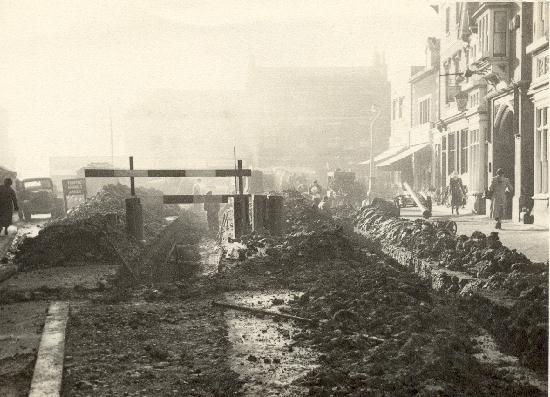 |
|
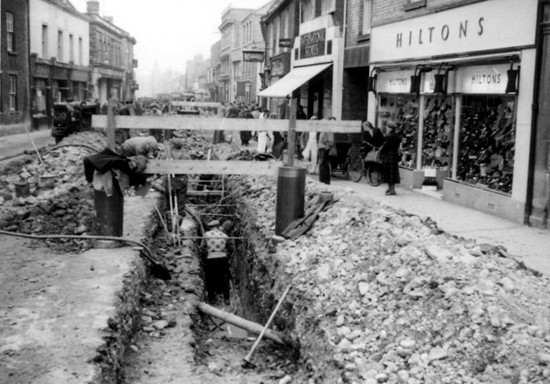 |
|
Work on the new
sewerage system underway in North Street during the summer of
1960 when excavations
revealed the town well dating back 700 years outside the Angel Hotel. It was found when a long deep trench was
dug down the middle of the road to accommodate drainage pipes and is
believed to have
been of 14th or 15th century origin. Old prints and
photographs of the Market Place clearly show the street pump that
was installed over this well as a public source of water supplies.
The project
was held up for several days while the
well was sealed
and filled in. The work caused major disruption to life in Bourne
during those weeks with watchmen's huts sited at various points to
ensure that no passing pedestrians had an accident. |
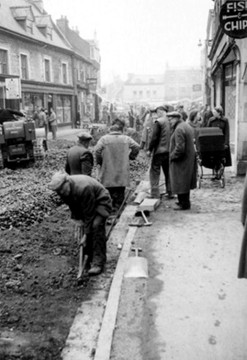 |
|
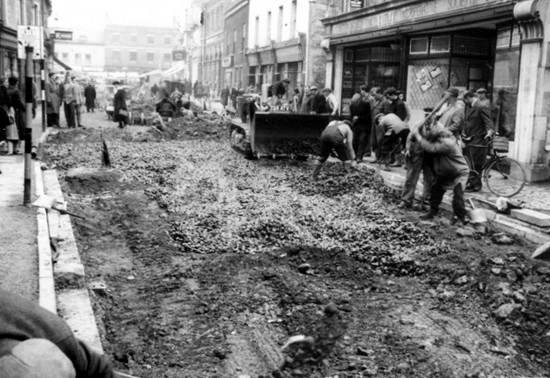 |
The new sewage works were officially opened on Friday 7th October 1960 when, ironically, the ceremony was disrupted by torrential rain that flooded the town and councillors, consulting engineers and contractors were marooned in the pumping station control room for almost two hours. Three inches of rainwater covered the streets, cars were stranded, houses and shops flooded and firemen were called out to several places for emergency pumping operations. Coggles Causeway was particularly badly hit and many houses were flooded when the Bourne Eau that runs through the area overflowed its banks.
At a meeting of Bourne UDC the following Tuesday, the flooding was referred to by Councillor Dr George Holloway, a former chairman of the council and of the Kesteven County Council's public health committee, who had been the guiding hand in the project for the re-sewering of Bourne and the badly needed extensions to the town's sewage disposal works. He told members: "If ever a town had cause to congratulate itself on the work of re-sewerage, then Bourne is that town. We only have to consider the position of North Street and what it would have been like in an abnormal rainfall like that on Friday in the old days when the foul sewers were also carrying the storm water overflow. These improved conditions have revealed the necessity of our re-sewering scheme and the separation of storm water from foul sewers. But with three inches of rain in one and a half to two hours, no town could hope to deal completely with such an occurrence and the installation of sewers capable of coping with abnormal conditions like this would bankrupt the town. "
But he was anxious to distance the council from blame over the flooding of the houses in Coggles Causeway and he told members: "There has been a great deal of vituperative comment from the public about the conditions here but the council was in no way responsible for the flooding which occurred there. At one time, the watercourse was diverted from private land and is now emptied into Coggles Causeway and it is a legal fact that the council has no responsibility or jurisdiction over that watercourse. If any damage ensues from flooding there, then the obvious course is for action against whoever diverted it or against the owner of the field where the diversion runs. It would pay owners whose homes were flooded to take a look for themselves and they will find that a lot of the flooding on Friday arose through badly roded dykes and watercourses. Bricks and stones which have been thrown in are raising the water level and a good deal of undergrowth needs clearing to improve conditions."
The sewerage system in the town remained under the control of Bourne UDC
until 1962 when responsibility for water and associated services passed to
the South Lincolnshire Water Board. This authority came to an end and its
responsibilities were handed over to the new Anglian Water Authority when
it was formed in April 1974 and is now known simply as Anglian Water.
An ongoing programme of maintenance and improvement has been carried on
ever since although there has been no major upgrading for the past ten years.
In that time, 350 new homes have been built and hundreds more are on the way,
mainly at Elsea Park but also at other locations around the town as part of
the residential development designed to double the size of Bourne over the
next decade. Anglian Water has now recognised the problem by announcing an
investment programme costing £4.7 million to upgrade the sewage works to cope
with a rising population to begin in the summer of 2007 with an expected
completion date of December 2008. The water authority said that the new
equipment would treat and screen waste water along with new pumps which should
mean fewer tankers on the roads. "We have anticipated the rise in demand from
the area and this work will mean reliable supplies and a better service for
years to come", said a spokesman.
|
THE SEWAGE TREATMENT WORKS |
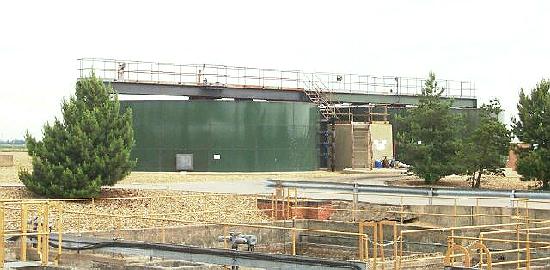 |
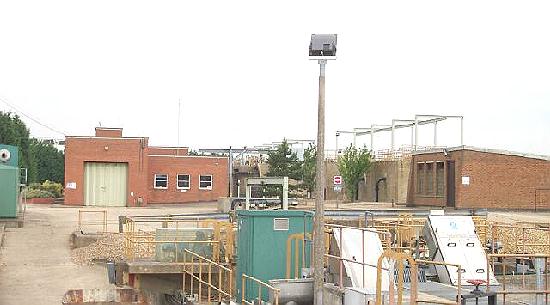 |
|
FROM THE ARCHIVES |
|
A dangerous fever has been raging in Bourne for
more than three months; and notwithstanding there is at present no
abatement of it, the inhabitants appear to be wanting in the common
precautions necessary for its prevention. I observe that the sewer
in the public high road in the North-street is suffered to pour
forth its filth on the top of the road instead of being carried
underground and thereby causes a most intolerable stench and
nuisance, not only to the parishioners but also to persons
travelling on the highway. This has too long been a reflection on
the town of Bourne, and in my opinion ought to be indicted as a
public nuisance. The commissioners of the road, I understand, have
liberally offered £50 towards the completion of this desirable
object. One of the inhabitants also states that the water flowing
from that pure source, the Wellhead, is polluted, nay poisoned, by
the refuse from the tan vats etc allowed (illegally) to run into it
at all times of the day and rendering it totally unfit for any use.
This water is all that the poorer part of the parishioners residing
in the Eastgate depend upon for a supply and the consequent
inconvenience and ill effects of this practice may be readily
conceived. I trust that this notice may meet the eye of some of the
influential persons in the town, who have hitherto been always most
anxious to remove every thing constituting a nuisance, and that
neither the public not parishioners may have any further cause of
complaint.
- letter to the Lincolnshire Chronicle signed
Viator, Friday 17th August 1838. |
REVISED JUNE 2013
See also
The West Street
pong Water
supplies

Go to:
Main Index Villages
Index
|





